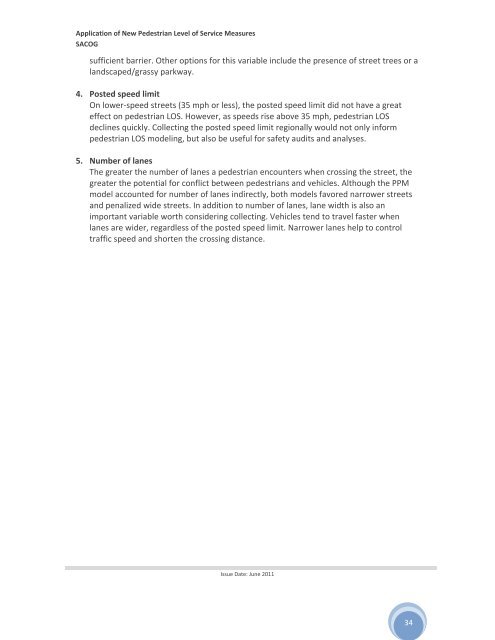Application of New Pedestrian Level of Service Measures - sacog
Application of New Pedestrian Level of Service Measures - sacog
Application of New Pedestrian Level of Service Measures - sacog
Create successful ePaper yourself
Turn your PDF publications into a flip-book with our unique Google optimized e-Paper software.
<strong>Application</strong> <strong>of</strong> <strong>New</strong> <strong>Pedestrian</strong> <strong>Level</strong> <strong>of</strong> <strong>Service</strong> <strong>Measures</strong><br />
SACOG<br />
sufficient barrier. Other options for this variable include the presence <strong>of</strong> street trees or a<br />
landscaped/grassy parkway.<br />
4. Posted speed limit<br />
On lower‐speed streets (35 mph or less), the posted speed limit did not have a great<br />
effect on pedestrian LOS. However, as speeds rise above 35 mph, pedestrian LOS<br />
declines quickly. Collecting the posted speed limit regionally would not only inform<br />
pedestrian LOS modeling, but also be useful for safety audits and analyses.<br />
5. Number <strong>of</strong> lanes<br />
The greater the number <strong>of</strong> lanes a pedestrian encounters when crossing the street, the<br />
greater the potential for conflict between pedestrians and vehicles. Although the PPM<br />
model accounted for number <strong>of</strong> lanes indirectly, both models favored narrower streets<br />
and penalized wide streets. In addition to number <strong>of</strong> lanes, lane width is also an<br />
important variable worth considering collecting. Vehicles tend to travel faster when<br />
lanes are wider, regardless <strong>of</strong> the posted speed limit. Narrower lanes help to control<br />
traffic speed and shorten the crossing distance.<br />
Issue Date: June 2011<br />
34
















